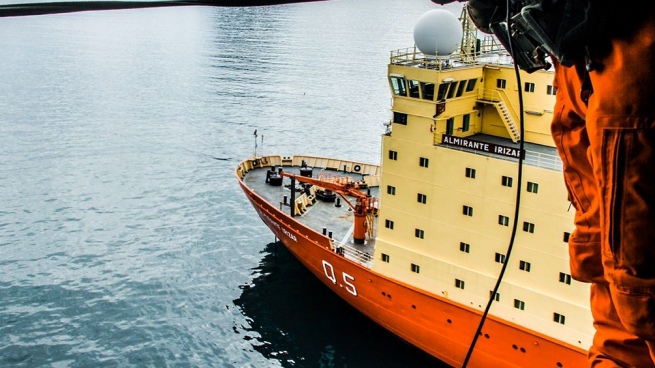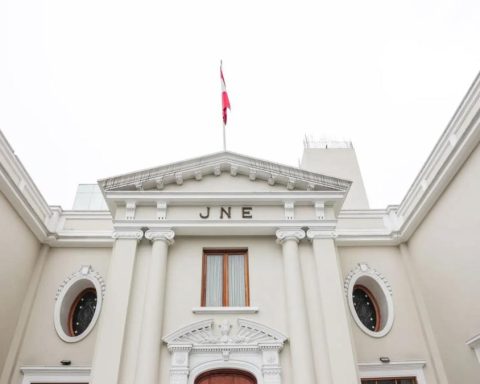The icebreaker Almirante Irízar completed this week the supply of the Base Belgrano IIthe closest permanent site on land to the South Pole, in an operation for which he had to take advantage the only weeks during the year in which the weather separates the sea ice from the great barriers and allows it to penetrate the Weddell Sea to reach its destination, the Joint Antarctic Command reported on Friday.
The Irízar had set sail from the port of Buenos Aires on January 12 on a trip that included a supply stopover in the Fuegian city of ushuaia and another to unload materials and personnel in the Orkney Base from Laurie Island; then sailed to the eastern shores of the Weddellwhere every summer between the second fortnight of January and the first of February the weather creates a channel in the great ice barriers on the coast and the frozen sea that allows it to approach Belgrano II, located about 1,300 kilometers from the South Pole and almost 5,000 from Buenos Aires.
The Antarctic Joint Command reported through its website that on February 2 at 10 p.m., with 4,573 miles sailed since leaving the port of Buenos Aires, the icebreaker embarked (to rest on the ice) at 13 nautical miles of the Joint Antarctic Base Belgrano 2.
For six successive daysthe crew of the Almirante Irízar operated taking advantage of favorable weather conditions with the two Sea King helicopters of the Second Naval Air Squadron embarked for the mission.
were made 170 flights with which the supply of the Base and the crew relief were carried out; General cargo, provisions, Antarctic gas oil, scientific material and waste collection were transported.
Once the task is finished, the icebreaker continues its journey towards a new stopover at the Orcadas Base.

Before setting sail from the port of Buenos Aires, the commander of the Irízar, the ship’s captain Carlos Musso Soler, had affirmed -in a dialogue with Télam- that “Antarctica is beautiful but when it’s quiet you have to take advantage and operate as fast as you canbecause when the weather changes, it doesn’t forgive and a mistake can leave you stranded or cost you your life”.
In this sense, he exemplified: “the window to access the Belgrano II base is for statistics between January 15 and February 15, the base is at nearly 78 degrees south latitude, about 1,300 kilometers from the South Pole. This navigation is called ‘penetration into the Weddell’ and it is done from Orcadas to Cape Norvegia, and from there it goes down the coastal channel that forms during those four weeks between the Filchner ice shelf and the marine pack”, as the specialists to the frozen sea surface.
“In the Weddell Sea the ice rotates clockwise, and the easterly wind allows the ice to move away from the coast opening a channel 20 miles wideprior to January 15, the Weddell Gyre still did not allow ice to break away from the coast, and after February 15, it begins to refreeze the sea near Belgrano II where temperatures can reach 80 degrees below zero“, he added.
“We have a lot of satellite information, ice charts, meteorology and winds, today’s commanders have a lot of information to avoid risks. I don’t cross the Drake Passage with a storm, a storm can catch me there if the weather changes suddenly, but We wait for the meteorologists to tell us that we will be able to cross safely. The ship is designed to tolerate the most extreme conditions, but it makes no sense to subject it to them unnecessarily,” explained the sailor.
“The Antarctic operation is a sum of concatenated naval and air assets, you can’t think of a single thing because any change in the weather can throw that plan off the rails. This icebreaker is very capable, but the weather could delay its planning at any time; That is why we must have operational flexibility such as that offered by Argentina’s air and naval resources that allow us to always work with alternative plans,” Musso Soler concluded.
The Antarctic Summer Campaign is under the operational control of the Joint Antarctic Command (Cocoantar), dependent on the Joint Chiefs of Staff of the Armed Forces.
The Belgrano II Base is located in Nunatak Bertrab, in Vahsel Bay on the Confin coast in Coats Land, about 1,300 kilometers from the South Pole already about 5,000 from the City of Buenos Aires and Internationally, it is the southernmost located on the mainland..
The region is characterized by having four months of polar night and four months of dayin which temperatures can reach tens of degrees below zero with winds up to 200 kilometers per hour.















